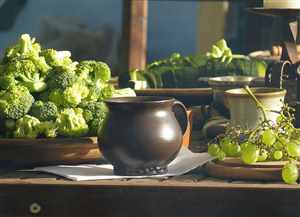Broccoli (Brassica oleracea)
Main Facts about Broccoli

Broccoli is an annual or biennial plant in the cabbage family whose large fleshy green flower head is eaten as a vegetable. The edible parts of broccoli are compact clusters of unopened flower buds and the attached portion of stem. The mass of flower heads is surrounded by leaves. The green buds develop first in one large central head and later in several smaller side shoots. Broccoli closely resembles the vegetable Cauliflower, which is the same species as broccoli, Brassica oleracea, but a different cultivar.
Broccoli was developed from wild cabbage in Italy around 6th century B.C. The name Broccoli comes from the Italian plural of “broccolo”, which means "cabbage sprout".
Broccoli was first introduced to the United States by Italian immigrants, but did not become generally known there until the 1920s.
Using Broccoli
Broccoli is extremely nutritious. Here are the nutrition facts for Broccoli, according to the U.S. Food and Drug Administration. It is high in vitamin C (a half-cup contains 52 mg of vitamin C) and dietary fiber (3 g per serving size). Broccoli is low in sodium and calories (about 45 per serving size) and is fat-free. It has potassium, calcium, iron, zinc, magnesium, phosphorus, B6 and vitamin A. Plus, 4 g protein per serving size. It benefits digestion, the cardiovascular system and the immune system, and is believed to have anti-inflammatory and even cancer-preventing properties. Broccoli is a good source of antioxidants. Broccoli can help lower cholesterol in the blood and is especially powerful in the body’s detoxification process. Besides decreasing cholesterol level, Broccoli aids in keeping blood vessels strong. Broccoli contains antioxidants lutein and zeaxanthin that are great for eye health: they protect against macular degeneration and cataracts. Probably the most publicized health benefit of broccoli is its possible ability to help reduce breast cancer risk.Cooking with Broccoli

How to grow Broccoli
Broccoli is a cool-season plant that can be cultivated in the spring or fall. Broccoli can grow in full sun in moist, fertile and slightly acidic soil with temperatures as low as 40F. If you plant Broccoli in spring, seed or set transplants 2 to 3 weeks before average last frost date. To determine the best time for setting your fall transplants, count backward from the first fall frost in your area and add about 10 to the days to harvest from transplants. A fall seeding is the best for a warm climate, as broccoli flourishes in cool weather. Plant seeds in mid- to late-summer in most places. Broccoli has a high nitrogen requirement. Add organic matter to the soil throughout the year to ensure an adequate supply of nutrients when broccoli is planted. Fertilize 3 weeks after replanting. Water regularly, especially in drought conditions. All varieties of Broccoli need moisture. Do not get heads wet when watering. Broccoli roots are not deep, do not dig soil around. Suppress weeds with mulch. Mulching around the plants helps to preserve soil moisture and reduces the soil temperature. Harvest before the heads flower. If there are yellow petals on a head, harvest immediately. For best taste, harvest in the morning. Since most varieties have side-shoots that will continue to grow after the main head is cut, you usually can continue to harvest Broccoli for several weeks.| Broad bean |
Buckthorn
|